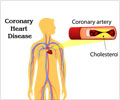In a study of nearly 750,000 men, researchers found that the more aerobically fit men were in late adolescence, the less likely they were to have a heart attack 30 or 40 years later.

The study, published online today (Wednesday) in the European Heart Journal [1], found that the relationship between aerobic fitness and heart attack occurred regardless of the men's body mass index (BMI) when they were teenagers. However, fit but overweight or obese men had a significantly higher risk of a heart attack than unfit, lean men.
Professor Peter Nordström, of Umeå University, Umeå, Sweden, who led the research, said: "Our findings suggest that high aerobic fitness in late adolescence may reduce the risk of heart attack later in life. However, being very fit does not appear to fully compensate for being overweight or obese in respect to this risk. Our study suggests that it's more important not to be overweight or obese than to be fit, but that it's even better to be both fit and a normal weight."
Prof Nordström and his colleagues analysed data from 743,498 Swedish men who underwent medical examinations at the age of 18 when they were conscripted into the Swedish armed forces between 1969-1984. Aerobic fitness was measured by a cycle test where the resistance was gradually increased until they were too exhausted to continue.
The researchers found that every 15% increase in aerobic fitness was linked to an approximately 18% reduced risk of a heart attack (myocardial infarction or MI) 30 years later after adjusting for various confounding factors including socioeconomic background and BMI. The results also suggested that regular cardiovascular training in late adolescence was independently associated with an approximately 35% reduced risk of an early heart attack in later life.
"There were 7,575 myocardial infarctions in 620,089 men during the total follow-up time where aerobic fitness was measured, which means the cumulative incidence was about 1222 per 100,000 men," explained Prof Nordström. "There were 271,005 men (43.7%) who were normal weight or lean, and who had an aerobic fitness that was better than the average. Among these lean, fit men there were 2176 MIs, resulting in a cumulative incidence of about 803 MIs per 100,000 men. Thus, the cumulative incidence of MIs was reduced by about 35% in this group."
Advertisement
"The relationship between aerobic fitness and heart disease is complex and may well be influenced by confounding factors that were not investigated in this study. For instance, some people may have a genetic predisposition to both high physical fitness and a low risk of heart disease. In a recent study of twins, we found that 78% of the variation in aerobic fitness at the time of conscription is related to genetic factors."
Advertisement
The men were followed for an average of 34 years (ranging from 5-41 years) until the date of a myocardial infarction, death or 1 January 2011, whichever came first. To investigate the link between aerobic fitness and risk of a later heart attack, the men's results were divided in five groups. Compared with men in the highest fifth for aerobic fitness, men in the lowest fifth had 2.1-fold increased risk of a heart attack during the follow-up period, after adjusting for BMI, age, place and year of conscription.
To investigate the joint effect of BMI and fitness with respect to risk of heart attacks, BMI were divided into four groups that matched the World Health Organization's BMI definitions: underweight/lean (BMI less than 18.5 kg/m2), normal weight (BMI between 18.5 and 25 kg/m2), overweight (BMI between 25-30 kg/m2) and obese (BMI more than 30 kg/m2). In all four BMI groups, the risk of a later heart attack was increased significantly when comparing the least fit with the most fit. However, the fittest obese men had nearly double (71%) the risk of a heart attack than did the most unfit, but lean men, and more than four-fold increased risk compared to the fittest lean men. A similar pattern was seen for overweight men when compared with normal weight men.
There are some limitations to the research. These include the fact that the men's BMI, fitness and blood pressure was only measured at the time of conscription so it is not known if and how these factors might have changed in later years; the research was carried out in young men and may not apply to women or the elderly; and the effect of smoking could be evaluated only in a sub-group of 23,000 men.
Prof Nordström said: "As far as we know, this is the first study to investigate the links between an objective measure of physical fitness in teenagers and risk of heart attack in the general population. Further studies are needed to investigate the clinical relevance of these findings, but given the strong association that we have found, the low cost and easy accessibility of cardiovascular training, and the role of heart disease as a major cause of illness and death worldwide, these results are important with respect to public health."
Source-Eurekalert















